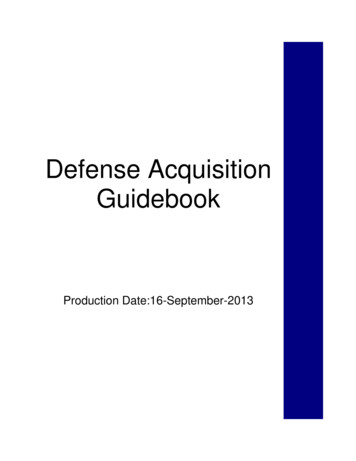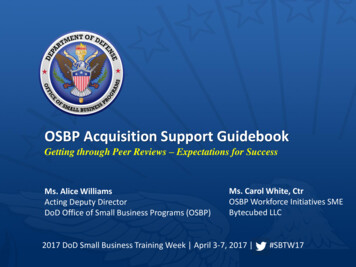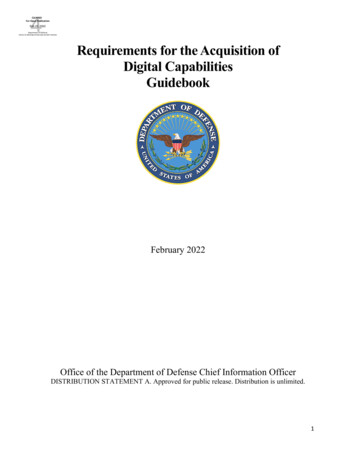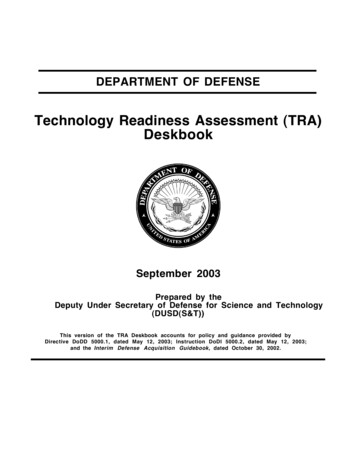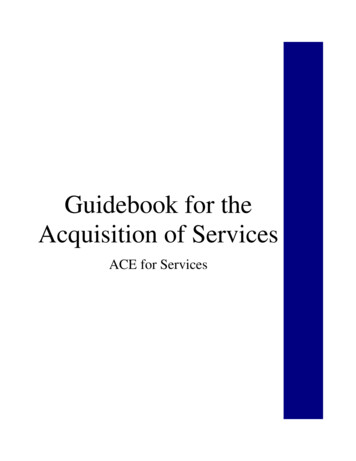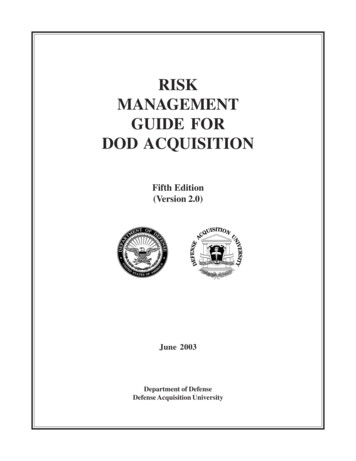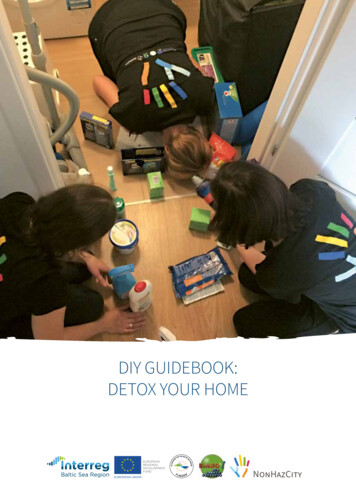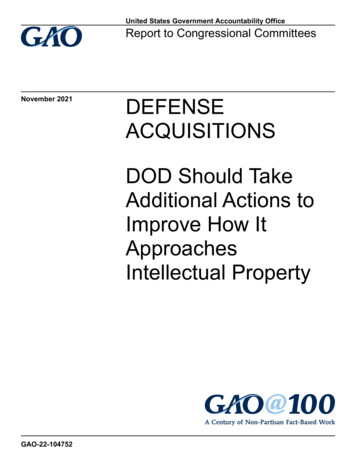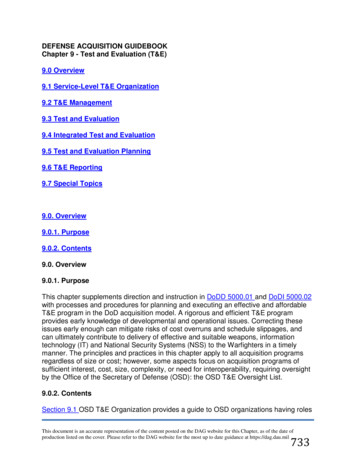
Transcription
DEFENSE ACQUISITION GUIDEBOOKChapter 9 - Test and Evaluation (T&E)9.0 Overview9.1 Service-Level T&E Organization9.2 T&E Management9.3 Test and Evaluation9.4 Integrated Test and Evaluation9.5 Test and Evaluation Planning9.6 T&E Reporting9.7 Special Topics9.0. Overview9.0.1. Purpose9.0.2. Contents9.0. Overview9.0.1. PurposeThis chapter supplements direction and instruction in DoDD 5000.01 and DoDI 5000.02with processes and procedures for planning and executing an effective and affordableT&E program in the DoD acquisition model. A rigorous and efficient T&E programprovides early knowledge of developmental and operational issues. Correcting theseissues early enough can mitigate risks of cost overruns and schedule slippages, andcan ultimately contribute to delivery of effective and suitable weapons, informationtechnology (IT) and National Security Systems (NSS) to the Warfighters in a timelymanner. The principles and practices in this chapter apply to all acquisition programsregardless of size or cost; however, some aspects focus on acquisition programs ofsufficient interest, cost, size, complexity, or need for interoperability, requiring oversightby the Office of the Secretary of Defense (OSD): the OSD T&E Oversight List.9.0.2. ContentsSection 9.1 OSD T&E Organization provides a guide to OSD organizations having rolesThis document is an accurate representation of the content posted on the DAG website for this Chapter, as of the date ofproduction listed on the cover. Please refer to the DAG website for the most up to date guidance at https://dag.dau.mil733
in the accomplishment or overseeing the DoD T&E mission.Section 9.2 Service-level T&E Management identifies the top level managementstructure for the Services and the Major Range and Test Facilities Base (MRTFB).Section 9.3 Test and Evaluation describes the different types of T&E and test events.Section 9.4 Integrated Test and Evaluation defines integrated testing and describes howall areas within T&E utilize Integrated Testing.Section 9.5 T&E Planning describes actions needed to develop an Evaluation Plan,Test and Evaluation Strategy (TES), Test and Evaluation Master Plan (TEMP), and testplan.Section 9.6 T&E Reporting describes actions and documentation needed to report T&Eresults and evaluations.Section 9.7 Special Topics addresses T&E programs deviating from the DoDI 5000.02Defense Acquisition System model (e.g., associated with urgent needs programs,defense business systems, National Security Systems (NSS), etc.).Section 9.8 Best Practices presents examples of best practices to improve planning,execution, and reporting of T&E.Section 9.9 Prioritizing Use of Government Test Facilities for T&E provides informationon the mandate to use Government test facilities for T&E.Throughout this chapter, interpret the terms developmental and operational as broadstatements of the types of testing or evaluation, and not as the testing controlled by aparticular organization.9.1. OSD T&E Organization9.1.1. OSD T&E Oversight List9.1.2. Director of Operational Test and Evaluation9.1.3. Deputy Assistant Secretary of Defense for Developmental Test andEvaluation9.1. OSD T&E OrganizationThe Director of Operational Test and Evaluation (DOT&E) for operational test andevaluation (OT&E) and live fire test and evaluation (LFT&E), and the Deputy AssistantSecretary of Defense for Developmental Test and Evaluation (DASD(DT&E)) within theoffice of the Assistant Secretary of Defense for Research and Engineering (ASD(R&E))This document is an accurate representation of the content posted on the DAG website for this Chapter, as of the date ofproduction listed on the cover. Please refer to the DAG website for the most up to date guidance at https://dag.dau.mil734
in the Office of the Under Secretary of Defense for Acquisition, Technology andLogistics (USD(AT&L)) provide oversight and policy for T&E of certain acquisitionprograms within OSD. The DASD(DT&E) also serves as the Director, Test ResourceManagement Center ( TRMC ) and has responsibility for oversight of DoD T&Eresources and infrastructure. By law, DASD(DT&E) closely coordinates with DeputyAssistant Secretary of Defense for Systems Engineering (DASD(SE)), and routinelycoordinates with other OSD organizations, such as Cost Assessment and ProgramEvaluation (CAPE).DOT&E and DASD(DT&E) share or coordinate on the following responsibilities: Prescribe policies and procedures for the T&E within the DoDProvide advice and make recommendations to the Secretary of Defense(SecDef),Deputy SecDef (DepSecDef), and USD(AT&L); as well as supportOverarching Integrated Product Teams (OIPTs) and Defense AcquisitionBoards/Information Technology Acquisition Boards for programs on the OSDT&E Oversight ListDevelop, in consultation with the DoD Components, the OSD T&E Oversight ListEnsure the adequacy of T&E strategies and plans for programs on the OSD T&EOversight ListEnsure DoD Components do not terminate or substantially reduce participation injoint Acquisition Category (ACAT) ID or ACAT IAM programs withoutRequirements Authority review and USD(AT&L) approvalAttend systems engineering technical reviewsMonitor and review DT&E, OT&E, and LFT&E events of oversight programsParticipate in the operational test readiness review (OTRR) process by providingrecommendations concerning a systems readiness for operational testingProvide independent performance, schedule, and T&E assessments to theDefense Acquisition Executive Summary (DAES) processProvide representatives to the T&E working-level integrated product team ( T&EWIPT ) for oversight programs to assist program managers (PMs) in developingtheir strategy as well as preparing a TES / TEMP9.1.1. OSD T&E Oversight ListThe DOT&E and the DASD(DT&E), jointly, and in consultation with the DoD ComponentT&E executives and other offices as appropriate, publish an annual OSD T&E OversightList . DOT&E and the DASD(DT&E) designate programs for DT&E, OT&E, and/orLFT&E oversight. They consider all programs for inclusion, regardless of ACAT level,and can add to or delete from the list at any time during the year. OSD considerationsfor inclusion on formal T&E oversight include: ACAT levelPotential for Joint designationPotential for establishment as an acquisition program (such as TechnologyProjects identified in Enclosure 3 of DoDI 5000.02 or a pre-Major DefenseThis document is an accurate representation of the content posted on the DAG website for this Chapter, as of the date ofproduction listed on the cover. Please refer to the DAG website for the most up to date guidance at https://dag.dau.mil735
Acquisition Program (MDAP))Stage of development or productionPotential for DAES reportingCongressional and/or DoD interestProgrammatic risk (cost, schedule, or performance)Past programmatic history of the developmental commandRelationship with other systems as part of a system-of-systems (SoS)Technical complexity of system9.1.2. Director of Operational Test and EvaluationThe DOT&E, a Principal Staff Assistant and advisor to the Secretary of Defense, hasspecific responsibilities as identified in DoDD 5141.02 , "Director of Operational Testand Evaluation", dated February 2, 2009. Sections 139 and 2399 of title 10 USCprescribe the duties for OT&E and section 2366 of title 10 USC for LFT&E . Foradditional information on the DOT&E office, visit the DOT&E website . For purposeshere, DOT&E: Prescribes policies and procedures for the conduct of OT&E and LFT&E for DoD.Assesses the adequacy of OT&E and LFT&E performed by the Services andoperational test agencies (OTAs) for programs on the OSD T&E Oversight List,for their effectiveness and suitability for advising the USD(AT&L) as well as forreporting to the SecDef and Congress.Advises the DoD Executive Agent for Space and the acquiring MilitaryDepartment on T&E of DoD Space MDAPs and other space programsdesignated for T&E oversight, in support of DoDD 3100.10 Space Policy, datedJuly 9, 1999.Manages:o The efforts to improve interoperability and information assurance (IA)through the operational evaluation of the systems under oversight andmajor exercises conducted by the Combatant Commands and the MilitaryDepartments.o The Joint Test and Evaluation (JT&E) Program .o The Joint Live Fire Program.o The Center for Countermeasures .o The activities of the Joint Aircraft Survivability Program .o The activities of the Joint Technical Coordinating Group for MunitionsEffectiveness and producing the Joint Munitions Effectiveness Manual.o The activities of the T&E Threat Resource Activity .Provides support to the Director, Joint Improvised Explosive Device DefeatOrganization ( JIEDDO ), consistent with DoDD 2000.19E Joint ImprovisedExplosive Device Defeat Organization (JIEDDO), dated February 14, 2006.Assists the Chairman of the Joint Chiefs of Staff (CJCS) in efforts to ensure theJoint Capabilities Integration and Development System ( JCIDS ) documents, interms verifiable through testing or analysis in support of CJCS Instruction3170.01 Joint Capabilities Integration and Development System, dated March 1,This document is an accurate representation of the content posted on the DAG website for this Chapter, as of the date ofproduction listed on the cover. Please refer to the DAG website for the most up to date guidance at https://dag.dau.mil736
2009, provides the expected joint operational mission environment, mission levelmeasures of effectiveness (MOEs), and key performance parameters (KPPs).Oversees and assesses operational capability demonstrations conducted by theMissile Defense Agency, consistent with DoDD 5134.09 Missile Defense Agency(MDA), dated September 17, 2009.Establishes policy on the verification, validation, and accreditation (VV&A) ofmodels and simulations used in support of OT&E and LFT&E.Oversees the International T&E (IT&E) program for the SecDef.Oversees and prescribes policy, as appropriate, to ensure adequate usage andverification of protection of human subjects and adherence to ethical standards inOT&E and LFT&E; in support of DoDD 3216.02 Protection of Human Subjectsand Adherence to Ethical Standards in DoD-Supported Research, datedNovember 8, 2011.9.1.3. Deputy Assistant Secretary of Defense for Developmental Test andEvaluationAs an advisor to the USD(AT&L) for DT&E through ASD(R&E), the DASD(DT&E) hasresponsibilities and duties as prescribed in section 139b of title 10 USC . For additionalinformation on DASD(DT&E), visit the ODASD(DT&E) website. For purposes here, theDASD(DT&E): Develops policies and guidance:o For the conduct of DT&E in the DoD (including integration anddevelopmental testing of software).o In coordination with the DOT&E, for the integration of DT with OT.o For the conduct of DT&E conducted jointly by more than one Componentor Defense Agency.o In coordination with DASD(SE), ensure the full integration of DT&Eactivities of the DoD into and consistent with the SE and developmentalplanning processes of the Department.Monitors and reviews the DT&E activities of the MDAPs, including approval ofthe TEMP and TES.Reviews and approves the DT&E plan within the TEMP for each DoD MDAP.Develops DT&E technical workforce, by providing advocacy, oversight, andguidance to elements of the acquisition workforce responsible for DT&E.Periodically reviews the organizations and capabilities of the Components andDefense Agencies with respect to DT&E; identifies needed changes orimprovements to such organizations and capabilities; and provides inputregarding needed changes or improvements to the strategic plan for DoD T&Eresources.Additionally, the DASD(DT&E) functions as Director, TRMC ; a field activity reportingdirectly to the USD(AT&L). DoDD 5105.71 , Department of Defense Test ResourceManagement Center (TRMC), dated March 8, 2004, states TRMC shall plan for andassess the adequacy of the Major Range Test Facility Base (MRTFB) . . . to provideThis document is an accurate representation of the content posted on the DAG website for this Chapter, as of the date ofproduction listed on the cover. Please refer to the DAG website for the most up to date guidance at https://dag.dau.mil737
adequate testing in support of development, acquisition, fielding, and sustainment ofdefense systems; and, maintain awareness of other T&E facilities and resources, withinand outside the Department, and their impacts on DoD requirements. The abovedirective also provides the specific responsibilities of the TRMC.TRMC provides reports and recommendations on current and projected MRTFBinfrastructure issues to ensure adequate capabilities and resources exist to supporttesting of DoD acquisition programs in accordance with responsibilities found in DoDD3200.11 Major Range and Test Facility Base (MRTFB), December 27, 2007.9.2. Service-Level T&E Management9.2.1. Program Managers9.2.2. T&E Board of Directors (BoD(ES))9.2.3. Component and Joint T&E Organizations9.2.3.1. Defense Information Systems Agency (DISA) T&E Executive (TEO)9.2.3.2. Assistant Deputy Under Secretary of the Army for Test & Evaluation(ADUSA(T&E))9.2.3.3. Director, Air Force Test & Evaluation (AF/TE)9.2.3.4. Department of the Navy Test & Evaluation Executive (OPNAV N091)9.2.4. Office of the Secretary of Defense T&E Management9.2.4.1. Developmental Test & Evaluation9.2.4.2. Operational Test & Evaluation9.2.5. Major Range and Test Facility Base9.2. Service-Level T&E Management9.2.1. Program ManagersUltimately, management responsibility for an acquisition programs T&E resides with thePM. However, the planning, executing, and reporting of T&E involves interactions,support, and oversight from other organizations within OSD, the Services, DefenseAgencies, and in some cases, other government agencies; as well as the systemcontractor(s). The PM charters a T&E WIPT early in the acquisition model to supportdevelopment of test strategies and estimates of resource requirements, strengtheningthe overall input to the programs integrated product team (IPT). For additionalThis document is an accurate representation of the content posted on the DAG website for this Chapter, as of the date ofproduction listed on the cover. Please refer to the DAG website for the most up to date guidance at https://dag.dau.mil738
information, consult Rules of the Road A Guide for Leading a Successful IntegratedProduct Team , October 1999.The PM, in concert with the user and the T&E community, coordinates DT&E,OT&E, LFT&E, family-of-systems (FoS) interoperability testing, IA testing, reliability andmaintainability (RAM) growth testing ( DTM 11003 , Reliability Analysis, Planning,Tracking, and Reporting, dated December 2, 2011), and modeling and simulation (M&S)activities, into an efficient continuum, closely integrated with requirements definition andsystems design and development. The PM has responsibility for the development andfinal approval of the TEMP that effectively describes the overall strategy for T&Esupporting the programs acquisition strategy and Systems Engineering Plan (SEP) ,and the resources necessary to execute the test program. MDAP/MAIS programs andprograms identified as being on OSD T&E Oversight List require Component levelapproval and OSD approval by DASD DT&E for programs on DT&E oversight andDOT&E for programs on OT&E and/or LFT&E oversight. For a program requiringLFT&E in accordance with section 2366 of title 10 USC , the PM must ensure timelysubmission of waivers and alternative plans to meet SecDef obligations to adviseCongress of any deviations from full up, system level (FUSL) LFT&E requirements. AllMDAP/MAIS programs should identify key leadership positions (KLPs) early in theacquisition process. An early charter for a T&E WIPT proves essential to the success ofa test and evaluation program.9.2.2. T&E Board of Directors (BoD(ES))Acting as the agent for the Service Vice Chiefs and equivalent OUSD and DefenseAgency representatives with T&E management responsibilities is the BOD ExecutiveSecretariat (BOD(ES)), consisting of the Service T&E principals and equivalent OUSDand Defense Agency representatives with T&E infrastructure managementresponsibilities. The BOD(ES): Endorses guidance and policy for T&E infrastructure and investmentmanagement to ensure a disciplined test process that supports weapon, IT &NSS system acquisition and operational, safety, suitability, and effectivenessassessments with a cost-effective infrastructure.Supports program review and advocacy for T&E capabilities and requisiteinfrastructure to OSD and Congress.Endorses the T&E Executive Agent Test Resources Master Plan.Approves and directs studies in support of T&E infrastructure management,standards, policy, configuration and investments.Endorses T&E infrastructure standards that promote interoperability andcommonality among test centers and ranges.Endorses processes for workload measurement, forecasting, utilization, and fullcost visibility application to T&E infrastructure investments and other relateddecisions.Endorses principles of T&E Reliance (joint OSD and individual Services efforts toThis document is an accurate representation of the content posted on the DAG website for this Chapter, as of the date ofproduction listed on the cover. Please refer to the DAG website for the most up to date guidance at https://dag.dau.mil739
maximize commonality, interoperability, and effective utilization of products andservices in support of the T&E infrastructure).Approves joint T&E requirements and recommends solutions from the needs andsolutions process for the Central T&E Investment Program ( CTEIP )consideration.Serves as the T&E representatives on the OSD chartered Defense Test andTraining Steering Group (DTTSG).9.2.3. Component and Joint T&E Organizations9.2.3.1. Defense Information Systems Agency (DISA) T&E Executive (TEO)The DISA T&E Executive serves as the Test, Evaluation, and Certification (TE&C)subject matter expert and Special Advisor to the DISA Director, DISA, and SeniorExecutive Leadership. The DISA T&E Executive duties and responsibilities include: Establishing and providing oversight of DISAs overarching TE&C strategies,policies, and procedures as well as missions and functions.Coordinating accomplishment of TE&C goals and investment strategies withDISAs Joint Interoperability Test Command (JITC) , program executive officer(PEOs), and PMOs for the development and management of the DISA T&EResource Management Plan.Providing oversight of DISA TE&C missions and functions, to include formulationof overarching T&E strategies, policies, and program direction.Providing policy oversight and resource management.Publishing and enforcing TE&C policies and guidance related to agencyacquisition programs and projects, examines TE&C strategies to ensureconsistent application of sound agile TE&C strategies, methodologies, andprocesses.Providing TE&C oversight and support for the agency in the development ofprogram documentation (e.g., TES and TEMP) to ensure governance, construct,infrastructure, and operations satisfy legal and regulatory requirements foradequate TE&C. Functions as the final TE&C review authority and signatory forTEMPs prior to Component Acquisition Executive (CAE) and OSD approval andsignature.Leading internal and external transitional TE&C concepts and methodologies toensure agile, mission capabilities-based, and Warfighter-relevant processes forIT Systems and Services for the agency and DoD.Representing the agency to the DoD T&E community, ensuring alignment withthe OSD and Joint Staff as a member of the T&E BoD(ES) and as a votingmember of the Military Communications-Electronics Board (MCEB)Interoperability Policy & Certification Panels (IP/ICP) as well as other OSD TE&Cadvisory working groups.Providing oversight and development of Agency’s TE&C career managementplan for recruiting, training, and retaining a professional TE&C workforce. ServesThis document is an accurate representation of the content posted on the DAG website for this Chapter, as of the date ofproduction listed on the cover. Please refer to the DAG website for the most up to date guidance at https://dag.dau.mil740
as the track manager for the DAWIA T&E component.9.2.3.2. Assistant Deputy Under Secretary of the Army for Test & Evaluation(ADUSA(T&E))Within the Army, the T&E Executive is the Director, T&E Office under the authority,direction, and control of the Deputy Under Secretary of the Army. Key Army T&EExecutive duties and responsibilities include: Serving as the senior advisor to the Secretary of the Army and the Chief of Staff,Army, on all Army T&E matters.Advising the Army Systems Acquisition Review Council (ASARC), the ArmyRequirements Oversight Council (AROC), and OIPTs on T&E matters.Approving test-related documentation for the Secretary of the Army andforwards, as appropriate, to OSD.Coordinating T&E matters with the Joint Staff and OSD, to include serving asprincipal Army interface on matters of T&E with the USD(AT&L) and DOT&E.Overseeing all Army T&E missions and functions, to include formulatingoverarching Army T&E strategy, policy, and program direction, providing policyoversight, and managing resources.Providing HQDA oversight on the funding of the Army Threat Simulator Program, Army Targets Program , and Army Instrumentation Program ; and coordinatewith the Project Manager for Instrumentation, Targets, and Threat Simulators (PM ITTS ).Overseeing Army responsibilities in Joint T&E, Foreign Comparative Testing(FCT), and multi-Service and multinational T&E acquisition programs.Serving as the Acquisition Workforce Functional Chief for the T&E acquisitionworkforce Career Field.9.2.3.3. Director, Air Force Test & Evaluation (AF/TE)The Air Force T&E Executive serves as the Director, Air Force Test and Evaluation(AF/TE), who serves under the authority and direction of the Secretary of the Air Force(SECAF) and the Chief of Staff of the Air Force (CSAF). In this capacity, the AF/TE: Functions as the sole focal point for Air Force T&E policy, guidance, direction,and oversight for the formulation, review, and execution of T&E plans, programs,and budgets.Functions as the chief T&E advisor to senior Air Force leadership on T&Eprocesses; DT&E, including contractor testing and LFT&E; OT&E; and the use ofM&S in T&E.Functions as the final T&E review authority and signatory for TEMPs prior to CAEand OSD approval and signature.Collaborates with requirements sponsors and system developers to improveoperational requirements, system development, and the fielding of operationallyeffective, suitable, safe, and survivable systems.This document is an accurate representation of the content posted on the DAG website for this Chapter, as of the date ofproduction listed on the cover. Please refer to the DAG website for the most up to date guidance at https://dag.dau.mil741
Reviews and/or prepares T&E information for timely release to OSD, Congress,and decision makers.Oversees the Air Force T&E infrastructure by determining the adequacy of T&Eresources required to support system acquisition activities. Administers variousT&E resource processes and chairs or serves on various committees, boards,and groups supporting T&E activities.Acts as the single point of entry for the Air Force Foreign Materiel Program.Manages the Air Force Joint Test & Evaluation Program according to DoDI5010.41 Joint Test and Evaluation (JT&E) Program, dated September 12, 2005.Functions as the certifying authority for T&E personnel for T&E Level 3 in theAcquisition Professional Development Program (APDP) when not delegated tothe Major Commands (MAJCOMs).9.2.3.4. Department of the Navy Test & Evaluation Executive (OPNAV N091)The Director, Test and Evaluation and Technology Requirements (OPNAV N091)serves as the Department of Navy (DON) T&E Executive. The DON T&E Executivereports to the Chief of Naval Operations (CNO), the Commandant of the Marine Corps(CMC), and the Principle Military Deputy to the Assistant Secretary of the Navy forResearch, Development, and Acquisition ( PMD ASN (RDA) ) on all matters pertainingto test and evaluation.The DON T&E Executive supports and advises the Vice Chief of Naval Operations(VCNO) regarding the VCNOs role on the T&E BOD and serves as the Navyrepresentative on the T&E BOD Executive Secretariat.The Director, Test and Evaluation and Technology Requirements (N091): Approves all Navy Test and Evaluation Master Plans for CNO.Establishes Navy T&E requirements and promulgates policy, regulation, andprocedures governing Navy T&E.Acts for CNO in resolving T&E requirements.9.2.4. Office of the Secretary of Defense T&E Management9.2.4.1. Developmental Test & EvaluationStatute and policy prescribes the management of DT by the DASD(DT&E), who, for allprograms on DT oversight, acts as the final approval authority for DT planning in theTEMP. ODASD(DT&E) staff representatives actively participate in acquisition programT&E WIPTs and provide advice to the T&E WIPT and PM; as well as providingindependent assessments to DASD(DT&E) on progress of performance of the testprogram and overall performance of the system. By statute, the DASD(DT&E) hasaccess to all test data and program information relevant to the execution of testing andfulfillment of the ODASD(DT&E) responsibilities. As a member of the OIPT, theDASD(DT&E) provides advice and recommendations at Defense Acquisition BoardThis document is an accurate representation of the content posted on the DAG website for this Chapter, as of the date ofproduction listed on the cover. Please refer to the DAG website for the most up to date guidance at https://dag.dau.mil742
(DAB), reviews and submits an independent Assessment for Operational TestReadiness (AOTR) to the Component Acquisition Executive (CAE) and USD(AT&L) forall programs on DT oversight prior to the CAE decision on material readiness for initialoperational test and evaluation (IOT&E).The PM should initiate early engagement with the ODASD(DT&E) and charter a T&EWIPT to aid in development of test strategies and building a TEMP. Given that DTspans the entire lifecycle of an acquisition program and remains a vital part of all levelsin the work structure of the systems engineering process, DASD(DT&E) expects duediligence from the PMs to ensure they base program and design decisions on testresults conducted and reported as independent verification steps in the process, andnot simply pulled from design and test learning processes. This effort requires close andcontinuous coordination with the SEP, Information Support Plan (ISP), and developingactivity engineering and test activities to ensure test plans and reports reflectindependent evaluation of the test data from the engineering staff vested in thedevelopment activities.Ideally, the PM bases all development decisions on test events and not schedules orcosts; but in the pragmatic environment of developing systems for the Warfighter, timeand cost prove significant drivers in pressuring test activities. Therefore, DT activitiesmust provide realistic T&E schedules to PMs during the establishment of the programsintegrated management schedule. This effort ensures the effective management of theoverall progress and cost of the program; particularly with complex systems that have anumber of dependent sub systems and technologies requiring efficient integration as anend product.As such, the DASD(DT&E): Develops policies and guidance for the planning, execution, and reporting ofDT&E in the DoD, according to section 139b of title 10 USC .Develops policies and guidance for the integration of DT and OT, in coordinationwith DOT&E.Publishes, in conjunction with DOT&E, a combined list of OSD T&E Oversightprograms for DT&E, OT&E, and LFT&E.Monitors and reviews the DT&E activities of MDAPs and other programs.Periodically conducts AOTRs.Provides advocacy, oversight, and guidance to the acquisition workforceresponsible for test and evaluation.Reviews and approves TES/TEMPs and selected DT&E plans.Periodically reviews the Services organizational DT&E capabilities to identifyneeded changes or improvements.9.2.4.2. Operational Test & EvaluationBy law, DOT&E prescribes policies and procedures for the conduct of OT&E in theDepartment of Defense. For programs on DOT&E OT oversight, DOT&E serves as theThis document is an accurate representation of the content posted on the DAG website for this Chapter, as of the date ofproduction listed on the cover. Please refer to the DAG website for the most up to date guidance at https://dag.dau.mil743
final approval authority for OT&E planning to include approval of the TEMP. DOT&Estaff representatives actively participates in acquisition program T&E WIPTs andprovide advice to the T&E WIPT and PM; as well as providing independentassessments to the DOT&E on progress of performance of the test program and overallperformance of the system. By law, DOT&E has access to all data and records DOT&Econsiders necessary to review in fulfillment of DOT&E OT&E responsibilities. DOT&Eserves as a member of both the Joint Requirements Oversight Council and the OIPT,providing advice and recommendations at DAB reviews; and has direct access to bothUSD(AT&L) and the SecDef, on all matters relating to operational test and evaluation.The PM should initiate early engagement with DOT&E through the Service and DefenseAgency T&E Executive and independent OTA and charter a T&E WIPT to aid indevelopment of T&E strategies and the TEMP. Since OT&E generally acts as thevalidation process in SE, early engagement of the OTA and DOT&E, as early as theAnalysis of Alternatives and requirements development, ensures a comprehensiveassessment of measurability and testability of requirements; and the associatedimplications to cost and schedule to effectively evaluate the system capabilities andlimitations. This requires close and continuous coordination with users, sponsors,developers, and
Defense Acquisition System model (e.g., associated with urgent needs programs, defense business systems, National Security Systems (NSS), etc.). Section 9.8 . Best Practices presents examples of best practices to improve planning, execution, and reporting of T&E. Section 9.9 Prioritizing Use of Government Test Facilities for T&E provides .
